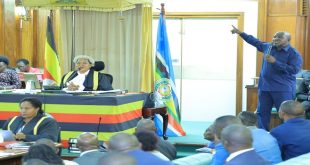Summary:
- The Bugoma Boundary Report’s relevance to International Forest Day celebrations is questioned amid concerns over Uganda’s declining forest cover and encroachment issues. Discrepancies in the report highlight challenges, while the broader context emphasizes the critical importance of forests for ecological, economic, and societal well-being.
The United Nations General Assembly established March 21st as the International Day of Forests in 2012 to celebrate and raise awareness of the importance of all types of forests. Countries are encouraged to undertake local, national, and international efforts to organize activities involving forests and trees, such as tree planting campaigns. The celebrations for this year’s International Day of Forests are underway. The theme for the 2024 celebration is “Forests and Innovation: New Solutions for a Better World.” The essence of the theme arises from the realization that the battle against deforestation requires new technological advancements, with 10 million hectares lost annually due to deforestation and approximately 70 million hectares affected by fires and human encroachment.
As Ugandans join the rest of the world in celebrating the importance of forests, we should recognize that our forest cover has been on a declining trend over the past two decades. According to Global Forest Watch, between 2000 and 2020, Uganda lost over 23% of its tree cover in both natural and planted forests. Apparently, all of Uganda’s protected forests have been encroached upon by growing industrialization, timber logging, and other human activities, including the famous Mabira forest, Zoka forest, and others. The most recent example is the Bugoma Central Forest Reserve, whose boundary report was released just a week ago to the public. While the forest has traditionally faced challenges such as the expansion of small-scale agriculture and population growth, the challenges of deforestation and forest degradation in Bugoma forest escalated when, in 2016, Uganda’s Ministry of Lands issued Bunyoro Kingdom with a freehold land title for a part of the forest that the kingdom claims. Thereafter, the kingdom leased the land it claims to Hoima Sugar Ltd. The company started destroying the forest in 2020. Satellite images from Maxar Worldview show that by March 3, 2022, approximately 2,800 hectares of the forest had been destroyed by the company as it continues to encroach upon the forest today.
With the long-awaited Bugoma Boundary opening report, we hoped it would offer solutions to the long-standing Bugoma issues, but the report is filled with discrepancies regarding its designated boundaries. According to the survey report, the computed area outlined in the boundary plan amounts to 39,492.620 hectares, hence the discrepancy of 1,651 hectares that raises significant questions, as it deviates from the originally gazetted 41,144 hectares. As noted by Kamugisha Dickens, Chairman of the Save Bugoma Campaign and CEO of AFIEGO in an article published in The Independent, the report neglects to address the perplexing issue of how the Bunyoro Kingdom came to be awarded customary land titles within a gazetted forest reserve. The lack of explanation leaves a critical gap in understanding the circumstances surrounding the allocation of land titles within Bugoma Forest.
However, the reality is clear: Forest cover is exposing Uganda to a number of hazards that have fundamental impacts on the livelihoods of people, their incomes, and the economy. According to World Bank statistics on climate change, floods impact nearly 50,000 people and cause the loss of over $62 million in GDP. According to the Red Cross Uganda, the recent floods that hit the country in late April and early May 2023 displaced at least 13,000 people and caused 18 deaths. Various infrastructures like roads, bridges, and electric transmission lines were destroyed in districts like Kisoro, Kabale, Kasese, Katakwi, Kanungu, Wakiso, and, more recently, washed away part of the Kampala-Masaka road straddling the Katonga River and others.
With the increasing climate chaos hitting not just Uganda but the globe, I urge all stakeholders to play an active role in restoring tree cover and standing against deforestation at all levels to protect the existing forests in Uganda. The forests, which nearly cover a third of the Earth’s land surface, are not just vast swathes of greenery. They constitute a vital component of almost every facet of life on our planet. They are critical ecosystems, providing habitats for most of the planet’s species and livelihoods for nearly one billion people. Healthy forests play a crucial role in mitigating climate change by acting as carbon sinks, absorbing billions of metric tonnes of CO2 annually. In Uganda particularly, forests are catalyzers of economic, ecological, and sociocultural well-being for many local host communities. For nearly all host communities depend on them for their livelihoods, access to clean water, food, and medicines, reduce the risk of land-based climate disasters and act as buffers between humans and wildlife and limit the spread of zoonotic infectious diseases.
In conclusion, I urge the government through its line agencies and ministries to combat deforestation and forest degradation, restore forest landscapes, enable rights-based land use to involve communities and unlock forest benefits and potentials. The government should come with innovations for essential early warning systems, sustainable commodity production, and empowering Indigenous Peoples through land mapping and climate finance access. If we manage forests well, they will give us goods and services that we cannot live without. If forests disappear, we will lose any prospect of sustainable development. Forests and trees are rooted in life and livelihoods. They are a renewable resource that can be grown, improved, and looked after. It would be hard to find a simpler and more universal way of changing the world for the better than by planting and managing trees.
Aryampa Brighton (aryampa.brighton@gmail.com). The writer is a lead, Natural Resource Management and Forestry under Inclusive Green Economy Network-East Africa (IGEN-EA) and CEO- Youth for Green Communities.
The Black Examiner®.
We come to you.
Want to send us a story or have an opinion to share? Send an email to editorial@examiner.co.ug or Join Our WhatsApp CHANNEL
 The Black Examiner Uganda & East Africa's Premier Breaking News Hub. Catch the Latest & Breaking Stories in Uganda Today. Exclusive reports and cutting-edge opinions, delivered to your device first and faster than ever
The Black Examiner Uganda & East Africa's Premier Breaking News Hub. Catch the Latest & Breaking Stories in Uganda Today. Exclusive reports and cutting-edge opinions, delivered to your device first and faster than ever




